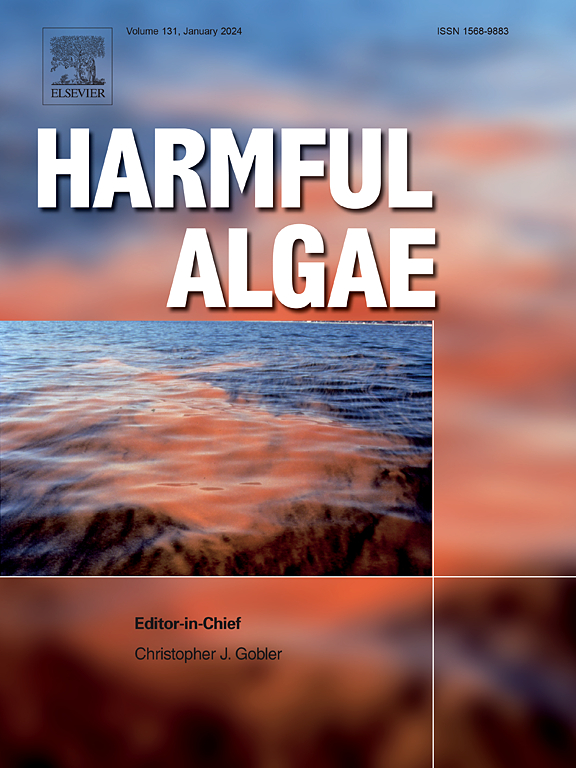基于Sentinel-3图像的内陆水库混合蓝藻制图新方法
IF 4.5
1区 生物学
Q1 MARINE & FRESHWATER BIOLOGY
引用次数: 0
摘要
监测和量化蓝藻华的发生对预防公共卫生风险和了解水生生态系统动态具有重要作用。卫星遥感已成为估算蓝藻生物量的重要数据来源。藻蓝蛋白(Phycocyanin, PC)是一种内陆水体蓝藻特有的色素,被广泛用作蓝藻藻类生物量的代用物。基于620nm左右的PC吸收特征,科学上已经建立了用于轨道卫星观测的生物光学模型,但所提出的PC模型限制了不同浓度范围的检索,并且依赖于针对特定水生环境校准的经验模型。本研究提出了一种混合机器学习的PC检索方法,该方法有效地采用了特定PC浓度范围的最优算法。在2020年11月至2021年12月期间收集了165个样本的原位数据集,以支持所提出方法的完整训练和验证。首先,采用随机森林算法对pc -低浓度水体(0 ~ 14 mg.m−3)和pc -高浓度水体(~ 14.1 ~ 300 mg.m−3)进行分类。然后,针对每个定义的类,校准单个PC估计算法。最后的pc -混合模型应用于通过三种方法(L2-WFR、6SV和ACOLITE)获得的Sentinel-3/OLCI大气校正图像。通过比较卫星估算的PC浓度和现场测量的PC浓度,评估了PC混合模型的性能。混合PC模型估计(中位数对称精度(ζ) = 25.35%)优于为PC浓度的整个范围校准的单个PC算法,证明了在光学动态水域中量化PC浓度的实际适用性。本文章由计算机程序翻译,如有差异,请以英文原文为准。
A novel hybrid cyanobacteria mapping approach for inland reservoirs using Sentinel-3 imagery
Detecting and quantifying cyanobacteria algal bloom occurrence plays an important role in preventing public health risks and understanding aquatic ecosystem dynamics. Satellite remote sensing has been used as an important data source to estimate cyanobacteria biomass based on pigment concentration. Phycocyanin (PC) is a unique pigment of inland water cyanobacteria and has been widely used as a proxy for cyanobacteria algal biomass. Based on the PC absorption feature around 620 nm, scientific efforts have been made to develop bio-optical models for orbital satellite observations, but proposed PC models limit the retrievals at different concentration ranges and depend on empirical models calibrated for specific aquatic environments. This study proposes a hybrid machine learning approach for PC retrieval that efficiently adopts the optimal algorithm for specific PC concentration ranges. An in-situ dataset of 165 samples was collected between November 2020 and December 2021 to support full training and validation of the proposed method. First, a Random Forest algorithm was applied to classify PC-low-concentration waters (0 – ∼14 mg.m−3) and PC-high-concentration waters (∼14.1 – 300 mg.m−3). Then, for each defined class, an individual PC estimation algorithm was calibrated. The final PC-hybrid model was applied to atmospherically corrected Sentinel-3/OLCI imagery derived by three approaches (L2-WFR, 6SV, and ACOLITE). The PC hybrid-model performance was evaluated by comparing the estimated PC concentration from satellite and in situ measurements. The hybrid PC model estimates (median symmetric accuracy (ζ) = 25.35%) outperformed the individual PC algorithms calibrated for the entire range of PC concentration, proving the practical applicability for quantifying PC concentration in optically dynamic waters.
求助全文
通过发布文献求助,成功后即可免费获取论文全文。
去求助
来源期刊

Harmful Algae
生物-海洋与淡水生物学
CiteScore
12.50
自引率
15.20%
发文量
122
审稿时长
7.5 months
期刊介绍:
This journal provides a forum to promote knowledge of harmful microalgae and macroalgae, including cyanobacteria, as well as monitoring, management and control of these organisms.
 求助内容:
求助内容: 应助结果提醒方式:
应助结果提醒方式:


